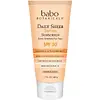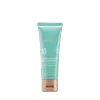What's inside
What's inside
 Key Ingredients
Key Ingredients

 Benefits
Benefits

 Concerns
Concerns

 Ingredients Side-by-side
Ingredients Side-by-side

Titanium Dioxide 6%
Cosmetic ColorantZinc Oxide 6%
Cosmetic ColorantWater
Skin ConditioningAloe Barbadensis Leaf Juice
Skin ConditioningPropanediol
SolventDecyl Glucoside
CleansingC12-15 Alkyl Benzoate
AntimicrobialCaprylic/Capric Triglyceride
MaskingLecithin
EmollientCocos Nucifera Oil
MaskingHelianthus Annuus Flower
Skin ConditioningGlyceryl Stearate
EmollientIron Oxides
Glyceryl Stearate Citrate
EmollientButyrospermum Parkii Butter
Skin ConditioningGlycerin
HumectantStearic Acid
CleansingPunica Granatum Extract
AstringentBeeswax
Emulsion StabilisingRosmarinus Officinalis Leaf Oil
MaskingCamellia Sinensis Extract
AntioxidantCaryodendron Orinocense Nut Oil
EmollientCucumis Sativus Extract
Skin ConditioningHippophae Rhamnoides Oil
EmollientTocopherol
AntioxidantHyaluronic Acid
HumectantArgania Spinosa Kernel Oil
EmollientMangifera Indica Seed Oil
EmollientXanthan Gum
EmulsifyingGlyceryl Caprylate
EmollientGlyceryl Undecylenate
EmollientSodium Polyacrylate
AbsorbentSaccharide Isomerate
HumectantTitanium Dioxide 6%, Zinc Oxide 6%, Water, Aloe Barbadensis Leaf Juice, Propanediol, Decyl Glucoside, C12-15 Alkyl Benzoate, Caprylic/Capric Triglyceride, Lecithin, Cocos Nucifera Oil, Helianthus Annuus Flower, Glyceryl Stearate, Iron Oxides, Glyceryl Stearate Citrate, Butyrospermum Parkii Butter, Glycerin, Stearic Acid, Punica Granatum Extract, Beeswax, Rosmarinus Officinalis Leaf Oil, Camellia Sinensis Extract, Caryodendron Orinocense Nut Oil, Cucumis Sativus Extract, Hippophae Rhamnoides Oil, Tocopherol, Hyaluronic Acid, Argania Spinosa Kernel Oil, Mangifera Indica Seed Oil, Xanthan Gum, Glyceryl Caprylate, Glyceryl Undecylenate, Sodium Polyacrylate, Saccharide Isomerate
Zinc Oxide 17.68%
Cosmetic ColorantWater
Skin ConditioningDicaprylyl Ether
EmollientCaprylic/Capric Triglyceride
MaskingC13-15 Alkane
SolventPolyglyceryl-3 Polyricinoleate
EmulsifyingGlyceryl Citrate/Lactate/Linoleate/Oleate
EmulsifyingCoco-Caprylate
EmollientSqualane
EmollientGlycerin
HumectantEctoin
Skin ConditioningBisabolol
MaskingCetyl Alcohol
EmollientHedychium Coronarium Root Extract
MaskingVaccinium Macrocarpon Seed Oil
Skin ConditioningXylitol
HumectantAnhydroxylitol
HumectantXylitylglucoside
HumectantTocopherol
AntioxidantGlucose
HumectantDisteardimonium Hectorite
StabilisingHectorite
AbsorbentIsostearic Acid
CleansingLecithin
EmollientPolyhydroxystearic Acid
Emulsifying1,2-Hexanediol
Skin ConditioningCaprylyl Glycol
EmollientSorbitan Isostearate
EmulsifyingZinc Oxide 17.68%, Water, Dicaprylyl Ether, Caprylic/Capric Triglyceride, C13-15 Alkane, Polyglyceryl-3 Polyricinoleate, Glyceryl Citrate/Lactate/Linoleate/Oleate, Coco-Caprylate, Squalane, Glycerin, Ectoin, Bisabolol, Cetyl Alcohol, Hedychium Coronarium Root Extract, Vaccinium Macrocarpon Seed Oil, Xylitol, Anhydroxylitol, Xylitylglucoside, Tocopherol, Glucose, Disteardimonium Hectorite, Hectorite, Isostearic Acid, Lecithin, Polyhydroxystearic Acid, 1,2-Hexanediol, Caprylyl Glycol, Sorbitan Isostearate
 Reviews
Reviews

Ingredients Explained
These ingredients are found in both products.
Ingredients higher up in an ingredient list are typically present in a larger amount.
This ingredient is an emollient, solvent, and texture enhancer. It is considered a skin-softener by helping the skin prevent moisture loss.
It helps thicken a product's formula and makes it easier to spread by dissolving clumping compounds.
Caprylic Triglyceride is made by combining glycerin with coconut oil, forming a clear liquid.
While there is an assumption Caprylic Triglyceride can clog pores due to it being derived from coconut oil, there is no research supporting this.
Learn more about Caprylic/Capric TriglycerideGlycerin is already naturally found in your skin. It helps moisturize and protect your skin.
A study from 2016 found glycerin to be more effective as a humectant than AHAs and hyaluronic acid.
As a humectant, it helps the skin stay hydrated by pulling moisture to your skin. The low molecular weight of glycerin allows it to pull moisture into the deeper layers of your skin.
Hydrated skin improves your skin barrier; Your skin barrier helps protect against irritants and bacteria.
Glycerin has also been found to have antimicrobial and antiviral properties. Due to these properties, glycerin is often used in wound and burn treatments.
In cosmetics, glycerin is usually derived from plants such as soybean or palm. However, it can also be sourced from animals, such as tallow or animal fat.
This ingredient is organic, colorless, odorless, and non-toxic.
Glycerin is the name for this ingredient in American English. British English uses Glycerol/Glycerine.
Learn more about GlycerinLecithin is a term for a group of substances found in the cell membranes of plants, animals, and humans. They are made up of mixture of phospholipids.
This ingredient has emollient and emulsifying properties.
As an emollient, lecithen helps soften the skin and creates a barrier to keep moisture in.
As an emulsifier, it also helps prevent water and oil ingredients from separating. Lecithin can also help ingredients be better absorbed by the skin.
This is because the phospholipids in lecithin produce liposomes. Liposomes help other ingredients get through the skin barrier.
Depending on the source of this ingredient, lecithin may not be fungal acne safe. This is because some sources of lecithin come from soybean oil, which may feed the malassezia yeast that feeds fungal acne.
We recommend reaching out to the brand you are purchasing from to inquire about the source of their lecithin.
Some other names for this ingredient include soy lecithin and deoiled soy lecithin.
Learn more about LecithinTocopherol (also known as Vitamin E) is a common antioxidant used to help protect the skin from free-radicals and strengthen the skin barrier. It's also fat soluble - this means our skin is great at absorbing it.
Vitamin E also helps keep your natural skin lipids healthy. Your lipid skin barrier naturally consists of lipids, ceramides, and fatty acids. Vitamin E offers extra protection for your skin’s lipid barrier, keeping your skin healthy and nourished.
Another benefit is a bit of UV protection. Vitamin E helps reduce the damage caused by UVB rays. (It should not replace your sunscreen). Combining it with Vitamin C can decrease sunburned cells and hyperpigmentation after UV exposure.
You might have noticed Vitamin E + C often paired together. This is because it is great at stabilizing Vitamin C. Using the two together helps increase the effectiveness of both ingredients.
There are often claims that Vitamin E can reduce/prevent scarring, but these claims haven't been confirmed by scientific research.
Learn more about TocopherolWater. It's the most common cosmetic ingredient of all. You'll usually see it at the top of ingredient lists, meaning that it makes up the largest part of the product.
So why is it so popular? Water most often acts as a solvent - this means that it helps dissolve other ingredients into the formulation.
You'll also recognize water as that liquid we all need to stay alive. If you see this, drink a glass of water. Stay hydrated!
Learn more about WaterZinc Oxide is a mineral broad-spectrum UV filter; it is the broadest UVA and UVB reflector approved by the FDA. It also has skin protectant and skin soothing properties.
Zinc oxide is one of the most effective broad-spectrum UV filters. It protects against UVB, UVAII, and UVAI. In comparison to its counterpart titanium dioxide, zinc oxide provides uniform and extended UVA protection.
Another great benefit? This ingredient is highly photostable so it won't degrade easily under sunlight.
A common myth is that mineral UV filters are widely believed to primarily reflect UV light.
However, modern research shows titanium dioxide absorbs UV radiation like chemical filters (~95% absorption & 5% reflection).
Zinc oxide has great skin soothing properties so you'll likely find this in sunscreens formulated for sensitive skin or babies/children. It is unlikely to cause "eye sting" like other sunscreen ingredients.
Regulatory agencies consider zinc oxide to be non-toxic and safe. It has also been shown to not penetrate the skin.
Unfortunately, this ingredient does leave a visible white cast. This is why mineral sunscreens are often less cosmetically elegant than chemical or hybrid ones.
In cosmetics, zinc oxide can be found in both non-nano and nano-sized forms. The nano version is used to reduce white cast and improve the texture of sunscreen formulas.
There are ongoing concerns surrounding nano-zinc oxide's impact on marine ecosystems and whether it can be absorbed into skin.
Regarding marine ecosystems and coral reefs, there is no conclusive evidence that any form of zinc oxide (or any other sunscreen ingredients) will cause harm. The science is still developing but many consumers are keeping a close eye on this issue.
Please note, many destinations have reef-safety sunscreen rules. For instance, the U.S. Virgin Islands advises all visitors to use non-nano mineral sunscreens.
There has also been some stir about whether micronized or nano zinc oxide has potential photoxicity and absorption through the skin/lungs.
An in-vitro (done in a test tube or petri dish) study demonstrated micronized zinc oxide to have potential phototoxicity. There's no need to fret; the EU Commission's Scientific Committee on Consumer Safety has stated, "The relevance of these findings needs to be clarified by appropriate investigations in vivo." Or in other words, further studies done on living organisms are needed to prove this.
Current research shows zinc oxide nanoparticles do not penetrate intact or sunburned skin. They either remain on the surface or in the outermost layer of dead skin (stratum corneum).
Zinc oxide is one of only two classified mineral UV filters with titanium dioxide being the other one.
Fun fact: Zinc has been used throughout history as an ingredient in paint and medicine. An Indian text from 500BC is believed to list zinc oxide as a salve for open wound. The Ancient Greek physician Dioscorides has also mentioned the use of zinc as an ointment in 1AD.
Learn more about Zinc Oxide